
Linear actuator
Encyclopedia
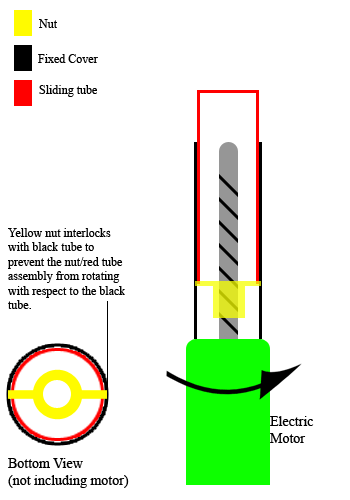
Actuator
An actuator is a type of motor for moving or controlling a mechanism or system. It is operated by a source of energy, usually in the form of an electric current, hydraulic fluid pressure or pneumatic pressure, and converts that energy into some kind of motion. An actuator is the mechanism by which...
that creates linear
Linear
In mathematics, a linear map or function f is a function which satisfies the following two properties:* Additivity : f = f + f...
motion (as opposed to rotary motion, e.g. of an electric motor
Electric motor
An electric motor converts electrical energy into mechanical energy.Most electric motors operate through the interaction of magnetic fields and current-carrying conductors to generate force...
).
Mechanical and hydraulic actuation are the most common methods of achieving the linear motion. Many linear actuators are driven by a non-linear motion.
Mechanical actuators
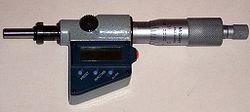
Machine
A machine manages power to accomplish a task, examples include, a mechanical system, a computing system, an electronic system, and a molecular machine. In common usage, the meaning is that of a device having parts that perform or assist in performing any type of work...
linear actuators typically operate by conversion of rotary motion into linear motion. Conversion is commonly made via a few simple types of mechanism:
- ScrewScrew (simple machine)A screw is a mechanism that converts rotational motion to linear motion, and a torque to a linear force. It is one of the six classical simple machines. The most common form consists of a cylindrical shaft with helical grooves or ridges called threads around the outside...
: Screw jack, ball screwBall screwA ball screw is a mechanical linear actuator that translates rotational motion to linear motion with little friction. A threaded shaft provides a helical raceway for ball bearings which act as a precision screw. As well as being able to apply or withstand high thrust loads, they can do so with...
and roller screwRoller screwA roller screw, also known as a planetary roller screw or satellite roller screw, is a low-friction precision mechanical device for converting rotational motion to linear motion, or vice versa. Planetary roller screws are most commonly used as the actuator mechanism in electro-mechanical linear...
actuators all operate on the principle of the simple machineSimple machineA simple machine is a mechanical device that changes the direction or magnitude of a force.In general, they can be defined as the simplest mechanisms that use mechanical advantage to multiply force. A simple machine uses a single applied force to do work against a single load force...
known as the screw. By rotating the actuator's nut, the screw shaft moves in a line. - Wheel and axleWheel and axleThe wheel and axle is one of six simple machines developed in ancient times and is in the category of a second- or third-class lever. In its simplest form it consists of a rod attached to a wheel so that their movements are coupled when one of the parts is turned...
: HoistHoist (device)A hoist is a device used for lifting or lowering a load by means of a drum or lift-wheel around which rope or chain wraps. It may be manually operated, electrically or pneumatically driven and may use chain, fiber or wire rope as its lifting medium. The load is attached to the hoist by means of a...
, winchWinchA winch is a mechanical device that is used to pull in or let out or otherwise adjust the "tension" of a rope or wire rope . In its simplest form it consists of a spool and attached hand crank. In larger forms, winches stand at the heart of machines as diverse as tow trucks, steam shovels and...
, rack and pinionRack and pinionA rack and pinion is a type of linear actuator that comprises a pair of gears which convert rotational motion into linear motion. A circular gear called "the pinion" engages teeth on a linear "gear" bar called "the rack"; rotational motion applied to the pinion causes the rack to move, thereby...
, chain driveChain driveChain drive is a way of transmitting mechanical power from one place to another. It is often used to convey power to the wheels of a vehicle, particularly bicycles and motorcycles...
, belt drive, rigid chainRigid chain actuatorA rigid chain actuator, known variously as a linear chain actuator, push-pull chain actuator, electric chain actuator or column-forming chain actuator, is a specialized mechanical linear actuator used in window operating, push-pull material handling and lift applications...
and rigid beltRigid belt actuatorA rigid belt actuator, also known as a push-pull belt actuator or zipper belt actuator, is a specialized mechanical linear actuator used in push-pull and lift applications. The actuator is a belt and pinion device that forms a telescoping beam or column member to transmit traction and thrust...
actuators operate on the principle of the wheel and axle. By rotating a wheel/axle (e.g. drumCylinder (geometry)A cylinder is one of the most basic curvilinear geometric shapes, the surface formed by the points at a fixed distance from a given line segment, the axis of the cylinder. The solid enclosed by this surface and by two planes perpendicular to the axis is also called a cylinder...
, gearGearA gear is a rotating machine part having cut teeth, or cogs, which mesh with another toothed part in order to transmit torque. Two or more gears working in tandem are called a transmission and can produce a mechanical advantage through a gear ratio and thus may be considered a simple machine....
, pulleyPulleyA pulley, also called a sheave or a drum, is a mechanism composed of a wheel on an axle or shaft that may have a groove between two flanges around its circumference. A rope, cable, belt, or chain usually runs over the wheel and inside the groove, if present...
or shaft) a linear member (e.g. cableWire ropethumb|Steel wire rope Wire rope is a type of rope which consists of several strands of metal wire laid into a helix. Initially wrought iron wires were used, but today steel is the main material used for wire ropes....
, rack, chainRoller chainRoller chain or bush roller chain is the type of chain drive most commonly used for transmission of mechanical power on many kinds of domestic, industrial and agricultural machinery, including conveyors, wire and tube drawing machines, printing presses, cars, motorcycles, and simple machines like...
or beltBelt (mechanical)A belt is a loop of flexible material used to link two or more rotating shafts mechanically. Belts may be used as a source of motion, to transmit power efficiently, or to track relative movement. Belts are looped over pulleys. In a two pulley system, the belt can either drive the pulleys in the...
) moves. - CamCamA cam is a rotating or sliding piece in a mechanical linkage used especially in transforming rotary motion into linear motion or vice-versa. It is often a part of a rotating wheel or shaft that strikes a lever at one or more points on its circular path...
: Cam actuatorCam actuatorA cam actuator is a linear actuator that functions on a principle similar to that of the wedge. As a wheel-like cam rotates, its eccentric shape provides thrust at the base of a shaft....
s function on a principle similar to that of the wedgeWedgeWedge may refer to:Mathematics:* Triangular prism, a parallel triangle wedge* Wedge , a polyhedral solid defined by two triangles and three trapezoid faces* Wedge product, a mathematical term, named for the ∧ operator symbol used...
, but provide relatively limited travel. As a wheel-like cam rotates, its eccentric shape provides thrust at the base of a shaft.
Some mechanical linear actuators only pull (e.g. hoist, chain drive and belt drive) and others only push (e.g. cam actuator).
Mechanical actuators typically convert rotary motion of a control knob or handle into linear displacement via screws and/or gears to which the knob or handle is attached. A jackscrew
Jackscrew
A jackscrew is a type of jack which is operated by turning a leadscrew. In the form of a screw jack it is commonly used to lift heavy weights such as the foundations of houses, or large vehicles.-Advantages:...
or car jack is a familiar mechanical actuator. Another family of actuators are based on the segmented spindle
Segmented spindle
A segmented spindle, also known by the trademark Kataka, is a specialized mechanical linear actuator conceived by the Danish mechanical engineer Jens Joerren Soerensen during the mid 1990s. The actuator forms a telescoping tubular column, or spindle, from linked segments resembling curved...
. Rotation of the jack handle is converted mechanically into the linear motion of the jack head. Mechanical actuators are also frequently used in the field of lasers and optics to manipulate the position of linear stage
Linear stage
A linear stage or translation stage is a component of a motion system used to restrict an object to a single axis of motion. The term linear slide is often used interchangeably with "linear stage", though technically "linear slide" refers to a linear motion bearing, which is only a component of a...
s, rotary stage
Rotary stage
A rotary stage is a component of a motion system used to restrict an object to a single axis of rotation. The terms rotary table or rotation stage are often used interchangeably with rotary stage...
s, mirror mount
Mirror mount
A mirror mount is a device that holds a mirror. In optics research, these can be quite sophisticated devices, due to the need to be able to tip and tilt the mirror by controlled amounts, while still holding it in a precise position when it is not being adjusted.Precision mirror mounts can be quite...
s, goniometers and other positioning instruments. For accurate and repeatable positioning, index marks may be used on control knobs. Some actuators even include an encoder and digital position readout. These are similar to the adjustment knobs used on micrometer
Micrometer
A micrometer , sometimes known as a micrometer screw gauge, is a device incorporating a calibrated screw used widely for precise measurement of small distances in mechanical engineering and machining as well as most mechanical trades, along with other metrological instruments such as dial, vernier,...
s except that their purpose is position adjustment rather than position measurement.
Hydraulic actuators
Hydraulic actuators or hydraulic cylinderHydraulic cylinder
A Hydraulic cylinder is a mechanical actuator that is used to give a unidirectional force through a unidirectional stroke. It has many applications, notably in engineering vehicles.- Operation :...
s typically involve a hollow cylinder having a piston inserted in it. The two sides of the piston are alternately pressurized/de-pressurized to achieve controlled precise linear displacement of the piston and in turn the entity connected to the piston. The physical linear displacement is only along the axis of the piston/cylinder. This design is based on the principles of hydraulics
Hydraulics
Hydraulics is a topic in applied science and engineering dealing with the mechanical properties of liquids. Fluid mechanics provides the theoretical foundation for hydraulics, which focuses on the engineering uses of fluid properties. In fluid power, hydraulics is used for the generation, control,...
. A familiar example of a manually operated hydraulic actuator is a hydraulic car jack. Typically though, the term "hydraulic actuator" refers to a device controlled by a hydraulic pump
Hydraulic pump
Hydraulic pumps are used in hydraulic drive systems and can be hydrostatic or hydrodynamic.Hydrostatic pumps are positive displacement pumps while hydrodynamic pumps can be fixed displacement pumps, in which the displacement cannot be adjusted, or variable displacement pumps, which have a more...
.
Pneumatic actuators
Pneumatic actuators, or pneumatic cylinderPneumatic cylinder
Pneumatic cylinders are mechanical devices which utilize the power of compressed gas to produce a force in a reciprocating linear motion....
s, are similar to hydraulic actuators except they use compressed gas to provide pressure instead of a liquid.
Piezoelectric actuators
The piezoelectric effectPiezoelectricity
Piezoelectricity is the charge which accumulates in certain solid materials in response to applied mechanical stress. The word piezoelectricity means electricity resulting from pressure...
is a property of certain materials in which application of a voltage to the material causes it to expand. Very high voltages correspond to only tiny expansions. As a result, piezoelectric actuators can achieve extremely fine positioning resolution, but also have a very short range of motion. In addition, piezoelectric materials exhibit hysteresis
Hysteresis
Hysteresis is the dependence of a system not just on its current environment but also on its past. This dependence arises because the system can be in more than one internal state. To predict its future evolution, either its internal state or its history must be known. If a given input alternately...
which makes it difficult to control their expansion in a repeatable manner.
Electro-mechanical actuators
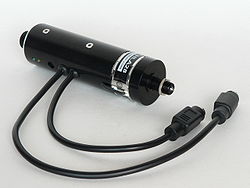
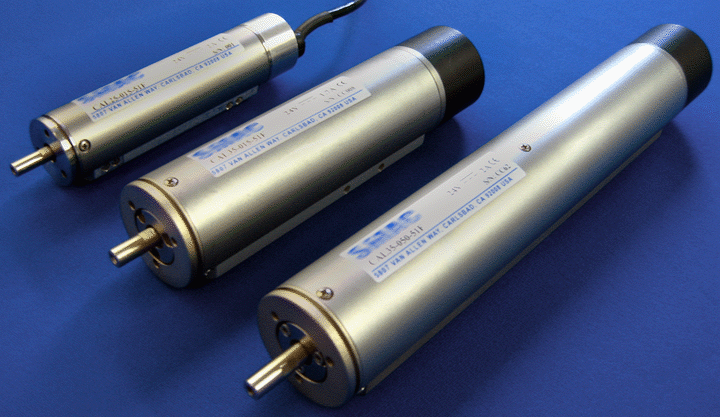
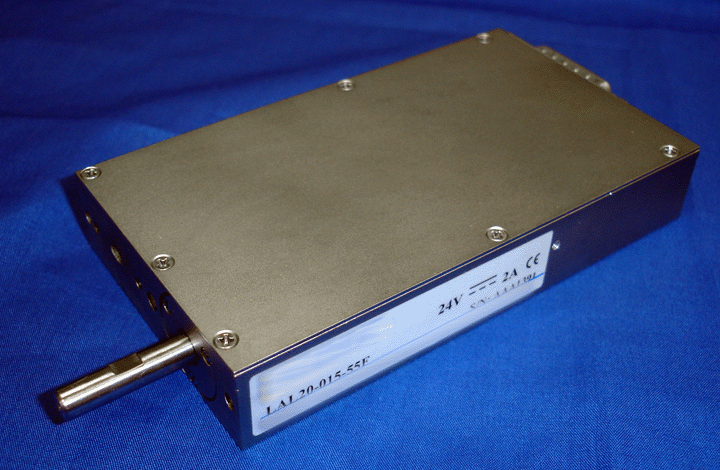
Simplified design
Typically, a rotary driver (e.g. electric motor) is mechanically connected to a lead screw so that the rotation of the electric motor will make the lead screw rotate. A lead screw has a continuous helical thread machined on its circumference running along the length (similar to the thread on a boltScrew
A screw, or bolt, is a type of fastener characterized by a helical ridge, known as an external thread or just thread, wrapped around a cylinder. Some screw threads are designed to mate with a complementary thread, known as an internal thread, often in the form of a nut or an object that has the...
). Threaded onto the lead screw is a lead nut
Square nut
A square nut is a four-sided nut. Compared to standard hex nuts, square nuts have a greater surface in contact with the part being fastened, and therefore provide greater resistance to loosening . They are also much less likely to become rounded-off after repeated loosening/tightening cycles...
or ball nut with corresponding helical threads. The nut is prevented from rotating with the lead screw (typically the nut interlocks with a non-rotating part of the actuator body). Therefore, when the lead screw is rotated, the nut will be driven along the threads. The direction of motion of the nut will depend on the direction of rotation of the lead screw. By connecting linkages to the nut, the motion can be converted to usable linear displacement. Most current actuators are built either for high speed, high force, or a compromise between the two. When considering an actuator for a particular application, the most important specifications are typically travel, speed, force, accuracy, and lifetime.
There are many types of motors that can be used in a linear actuator system. These include dc brush, dc brushless, stepper, or in some cases, even induction motors. It all depends on the application requirements and the loads the actuator is designed to move. For example, a linear actuator using an integral horsepower AC induction motor driving a lead screw can be used to actuate a large valve in a refinery. In this case, accuracy and move resolution down to a thousandth isn't needed, but high force and speed is. For electromechanical linear actuators used in laboratory instrumentation robotics, optical and laser equipment, or X-Y tables, fine resolution into the micron region and high accuracy may require the use of a fractional horsepower stepper motor
Stepper motor
A stepper motor is a brushless, electric motor that can divide a full rotation into a large number of steps. The motor's position can be controlled precisely without any feedback mechanism , as long as the motor is carefully sized to the application...
linear actuator with a fine pitch lead screw. There are many variations in the electromechanical linear actuator system. It's critical to understand the design requirements and application constraints to know which one would be best.
Standard vs compact construction
A linear actuator using standard motors will commonly have the motor as a separate cylinder attached to the side of the actuator, either parallel with the actuator or stick out to the side perpendicular to the actuator. Or the motor may be attached to the back end of the actuator. The drive motor is of typical construction with a solid drive shaft that is geared to the drive nut or drive screw of the actuator.Compact linear actuators use specially designed motors that try to fit the motor and actuator into the smallest possible shape.
- The inner diameter of the motor shaft can be enlarged, so that the drive shaft can be hollow. The drive screw and nut can therefore occupy the center of the motor, with no need for additional gearing between the motor and the drive screw.
- Similarly the motor can be made to have a very small outer diameter, but instead the pole faces are stretched out lengthwise so that the motor can still have very high torque while fitting in a small diameter space.
Principles
In the majority of linear actuator designs, the basic principle of operation is that of an inclined planeInclined plane
The inclined plane is one of the original six simple machines; as the name suggests, it is a flat surface whose endpoints are at different heights. By moving an object up an inclined plane rather than completely vertical, the amount of force required is reduced, at the expense of increasing the...
. The threads of a lead screw act as a continuous ramp that allows a small rotational force to be used over a long distance to accomplish movement of a large load over a short distance.
Variations
Many variations on the basic design have been created. Most focus on providing general improvements such as a higher mechanical efficiency, speed, or load capacity. There is also a large engineering movement towards actuator miniaturization.Most electro-mechanical designs incorporate a lead screw and lead nut. Some use a ball screw and ball nut. In either case the screw may be connected to a motor or manual control knob either directly or through a series of gears. Gears are typically used to allow a smaller (and weaker) motor spinning at a higher rpm to be geared down to provide the torque necessary to spin the screw under a heavier load than the motor would otherwise be capable of driving directly. Effectively this sacrifices actuator speed in favor of increased actuator thrust. In some applications the use of worm gear is common as this allow a smaller built in dimension still allowing great travel length.
A traveling-nut linear actuator has a motor that stays attached to one end of the lead screw (perhaps indirectly through a gear box), the motor spins the lead screw, and the lead nut is restrained from spinning so it travels up and down the lead screw.
A traveling-screw linear actuator has a lead screw that passes entirely through the motor.
In a traveling-screw linear actuator, the motor "crawls" up and down a lead screw that is restrained from spinning—the only spinning parts are inside the motor, and may not even be visible from the outside.
Some lead screws have multiple "starts". This means that they have multiple threads alternating on the same shaft. One way of visualizing this is in comparison to the multiple color stripes on a candy cane. This allows for more adjustment between thread pitch and nut/screw thread contact area, which determines the extension speed and load carrying capacity (of the threads), respectively.
Static load capacity
Linear screw actuators can have a static loading capacity, meaning that when the motor stops the actuator essentially locks in place and can support a load that is either pulling or pushing on the actuator.The braking force of the actuator varies with the angular pitch of the screw threads and the specific design of the threads. Acme threads have a very high static load capacity, while ball screw
Ball screw
A ball screw is a mechanical linear actuator that translates rotational motion to linear motion with little friction. A threaded shaft provides a helical raceway for ball bearings which act as a precision screw. As well as being able to apply or withstand high thrust loads, they can do so with...
s have an extremely low load capacity and can be nearly free-floating.
Generally it is not possible to vary the static load capacity of screw actuators without additional technology. The screw thread pitch and drive nut design defines a specific load capacity that cannot be dynamically adjusted.
Dynamic load capacity
Dynamic load capacity can be added to a linear screw actuator using an electromagnetic brakeElectromagnetic brake
An eddy current brake, like a conventional friction brake, is responsible for slowing an object, such as a train or a roller coaster. However, unlike electro-mechanical brakes, which apply mechanical pressure on two separate objects, eddy current brakes slow an object by creating eddy currents...
system, which applies friction to the spinning drive nut. For example a spring may be used to apply brake pads to the drive nut, holding it in position when power is turned off. When the actuator needs to be moved, an electromagnet counteracts the spring and releases the braking force on the drive nut.
Similarly an electromagnetic ratchet mechanism can be used with a linear screw actuator so that the drive system lifting a load will lock in position when power to the actuator is turned off. To lower the actuator, an electromagnet is used to counteract the spring force and unlock the ratchet.
Linear motors
A linear motorLinear motor
A linear motor is an electric motor that has had its stator and rotor "unrolled" so that instead of producing a torque it produces a linear force along its length...
is essentially a rotary electric motor laid down on flat surface. Since the motor moves in a linear fashion to begin with, no lead screw is needed to convert rotary motion to linear. While high capacity is possible, the material and/or motor limitations on most designs are surpassed relatively quickly due to a reliance solely on magnetic attraction and repulsion forces. Most linear motors have a low load capacity compared to other types of linear actuators.
Linear motors have an advantage in outdoor or dirty environments in that the two halves do not need to contact each other, and so the electromagnetic drive coils can be waterproofed and sealed against moisture and corrosion, allowing for a very long service life.
Telescoping linear actuator
Telescoping linear actuators are specialized linear actuators used where space restrictions or other requirements require. Their range of motion is many times greater than the unextended length of the actuating member.A common form is made of concentric tubes of approximately equal length that extend and retract like sleeves, one inside the other, such as the telescopic cylinder
Telescopic cylinder
Telescopic cylinders are a special design of hydraulic cylinder that provide an exceptionally long output travel from a very compact retracted length. Typically the collapsed length of a telescopic cylinder is 20 to 40%...
.
Other more specialized telescoping actuators use actuating members that act as rigid linear shafts when extended, but break that line by folding, separating into pieces and/or uncoiling when retracted. Examples of telescoping linear actuators include:
- Helical band actuatorHelical band actuatorA helical band actuator, generally known by the trademark Spiralift, is a complex and specialized linear actuator used in stage lifts and material handling lifts. The actuator forms a high-capacity telescoping tubular column .-Raison d'être:Pierre Gagnon was awarded a US patent for the “Push...
- Rigid belt actuatorRigid belt actuatorA rigid belt actuator, also known as a push-pull belt actuator or zipper belt actuator, is a specialized mechanical linear actuator used in push-pull and lift applications. The actuator is a belt and pinion device that forms a telescoping beam or column member to transmit traction and thrust...
- Rigid chain actuatorRigid chain actuatorA rigid chain actuator, known variously as a linear chain actuator, push-pull chain actuator, electric chain actuator or column-forming chain actuator, is a specialized mechanical linear actuator used in window operating, push-pull material handling and lift applications...
- Segmented spindleSegmented spindleA segmented spindle, also known by the trademark Kataka, is a specialized mechanical linear actuator conceived by the Danish mechanical engineer Jens Joerren Soerensen during the mid 1990s. The actuator forms a telescoping tubular column, or spindle, from linked segments resembling curved...
Advantages and disadvantages
| Actuator Type | Advantages | Disadvantages |
|---|---|---|
| Mechanical | Cheap. Repeatable. No power source required. Self contained. Identical behaviour extending or retracting. | Manual operation only. No automation. |
| Electro-mechanical | Cheap. Repeatable. Operation can be automated. Self-contained. Identical behaviour extending or retracting. DC or stepping motors. Position feedback possible. | Many moving parts prone to wear. |
| Linear motor | Simple design. Minimum of moving parts. High speeds possible. Self-contained. Identical behaviour extending or retracting. | Low force. |
| Piezoelectric | Very small motions possible. | Requires position feedback to be repeatable. Short travel. Low speed. High voltages required. Expensive. Good in compression only, not in tension. |
| Hydraulic | Very high forces possible. | Can leak. Requires position feedback for repeatability. External hydraulic pump required. Some designs good in compression only. |
| Pneumatic | Strong, light, simple, fast. | Precise position control impossible except at full stops | Wax motor | Smooth operation. | Not as reliable as other methods. |
| Segmented spindle | Very compact. Range of motion greater than length of actuator. | Both linear and rotary motion. |
| Moving coil | Force Force In physics, a force is any influence that causes an object to undergo a change in speed, a change in direction, or a change in shape. In other words, a force is that which can cause an object with mass to change its velocity , i.e., to accelerate, or which can cause a flexible object to deform... , position and speed Speed In kinematics, the speed of an object is the magnitude of its velocity ; it is thus a scalar quantity. The average speed of an object in an interval of time is the distance traveled by the object divided by the duration of the interval; the instantaneous speed is the limit of the average speed as... are controllable and repeatable. Capable of high speeds and precise positioning. Linear, rotary, and linear + rotary actions possible. | Requires position feedback Feedback Feedback describes the situation when output from an event or phenomenon in the past will influence an occurrence or occurrences of the same Feedback describes the situation when output from (or information about the result of) an event or phenomenon in the past will influence an occurrence or... to be repeatable. |
| MICA (moving iron controllable actuator) | High force and controllable. Higher force and less losses than moving coils. Losses easy to dissipate. Electronic driver easy to design and set up. | Stroke limited to several millimeters, less linearity than moving coils |

